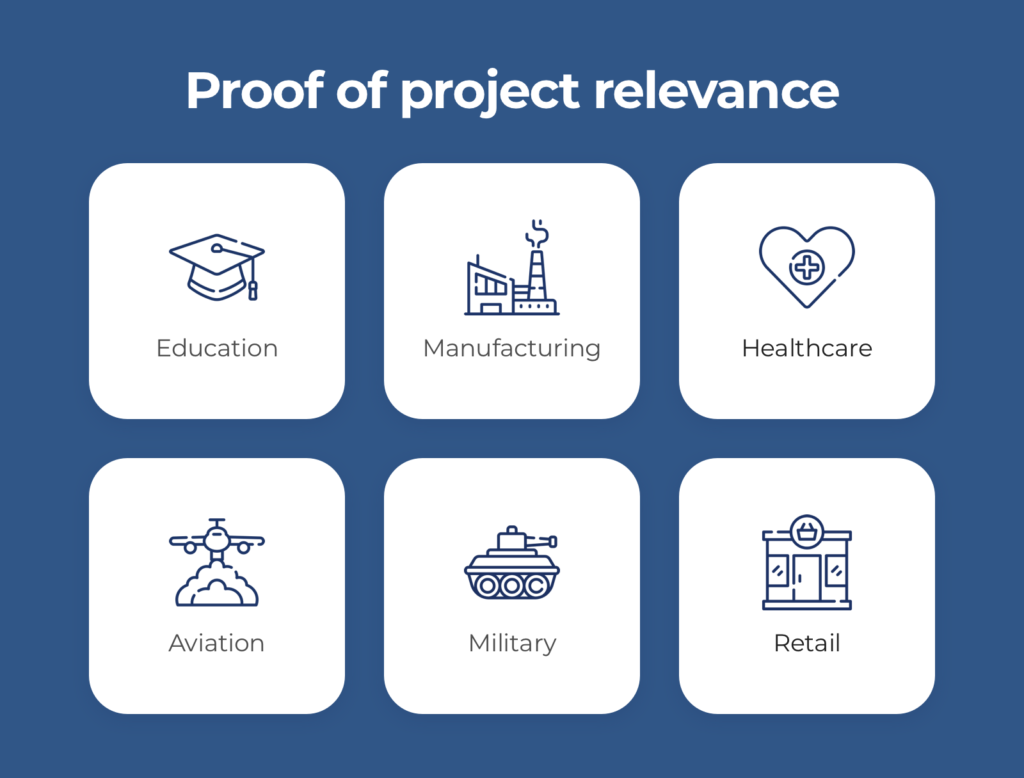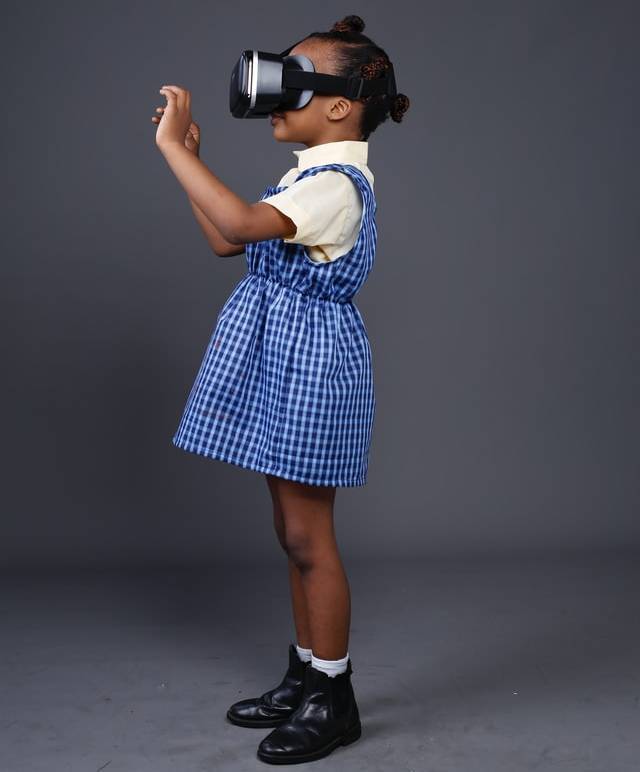Last Updated on June 28, 2024 by Team Experts
Augmented Reality in Education: Augmented reality is one of the fastest-growing technologies that enhance its position in our life each year. That’s why more companies are looking towards implementing AR in their business solutions. Education is an important field where AR can become a game changer. According to Statista, the global AR market in the education sector will reach $700 million by 2025. The number of mobile AR users will rise to 2.4 billion by 2023.
Let’s consider the benefits of AR and how to turn a traditional class into a captivating experience.
Augmented Reality in Education and Training
AR in education makes the learning process more fascinating and increases students’ productivity.
It puts students in an environment where they actually learn something through interaction, not just in a lecture. It expands the capability of what students can do.
Moreover, schools can cut the expenses on textbooks and other equipment like whiteboards, banners, etc. Students will connect with the teacher and access educational materials in the app.
AR has vast benefits for professional training courses too. Students learn complex subjects in an immersive environment without distractions.
For example, novice engineers won’t be allowed to fix a car engine without knowing its structure. With augmented reality, engineers can explore mechanisms in 3D projection and interact with it.
Benefits of AR Technologies in Education
AR can provide safer experiments and bring learning experience that goes beyond the physical lab. Teachers get highly engaged students that interact with both digital learning materials and lectures to dive deep into the topic.
So, let’s mention the main benefits of AR in education:
Immersiveness
Three-dimensional objects deliver a much more immersive experience in education because it enables the materials to come to life.
Instead of reading text and just scrolling, students can look at the objects
and disassemble them. This is highly important for engineering and medical students.
Visualization
Our brain is efficient at absorbing the information that is presented in well-executed visualization.
It means that AR helps to remember the material better. But there should be a high-resolution model to achieve actual results. Defective polygon 3D models can hurt students’ eyes and worsen visual perception.

Engagement
Innovative technologies like AR glasses and applications always capture students’ attention.
Children and adults would love to use their smartphones rather than textbooks and syllabuses. AR will increase students’ productivity and overall performance.

Opportunities
A novice pilot can’t fly a plane without careful training. Just like a young surgeon can’t perform first surgery without a mentor.
AR and mixed reality applications open up access to the required experience. For example, Microsoft Flight Simulator created real-life planes that allow pilots to practice their skills in VR headsets.
Encourage students to use their minds in a new way.
AR in the classroom can help students to become innovators and problem-solvers of their time.
With the integration of augmented reality, students can practice working together and learn how to implement good ideas into financial solutions in the future.
Also, AR is a useful simulation tool that will give students the advantage of getting help on assignments and homework without a professor present. This can increase the speed and efficiency of how well a student can work independently.
How to Implement AR in Education
If you want to develop an AR learning app, you have to understand the process of transforming your idea into a high-quality product. You can face some difficulties during augmented reality educational app development that should be solved beforehand.
Let’s consider what steps you need to follow to implement augmented reality in education.
Defining Target Audience
Having a great idea isn’t enough. Your learning app has to bring real value to educational establishments and training organizations. Otherwise, all the efforts may be wasted in vain.
So, before developing an AR app, you should conduct user research and create a full-featured plan.
You have to exactly understand your customers’ needs and expectations.
If you aim to create an educational app for professional development, contact the relevant company you want to collaborate with. You can’t build a solution for everyone, so it’s better to focus on a single client, figure out their demands, and create an app that meets their interests.
If you’re planning to make AR apps for schools and universities, your product should cover general requirements. The primary goals for educational establishments are AR textbooks, 3-dimensional objects, and student engagement.
Besides, you have to analyze your competitors to provide a better performance, quality polygon models, and some additional features.

Idea Validation
To understand whether your business idea is worth attention, you have to collect prior feedback. Prepare a business plan, design a prototype of your app, and reach investors. If you’re a startup, you have to follow all the investor’s demands. Still, investors’ requirements may differ from yours. They may ask to change some features or rebuild the AR learning app.

In this case, you have two options: find new investors or find a compromise. If you don’t want your idea to lose its initial value and uniqueness, it’s better to look for a new partner. Plus, rebuilding the whole concept of an AR app may be time-consuming.
MVP Creation
Minimum Viable Product is the preliminary version of the product with vital features only. Startups typically use MVP to manage usability testing and collect first feedback from users. It helps to gather data about target application users and show investors a working product.
MVP development helps you understand whether you need to add additional features and boost customer’s interests. Also, if your idea fails, it prevents your business from losses. At last, you have more chances to attract investors. Usually, investors are afraid of ideas on the paper so MVP can increase confidence.
Tech Stack
For developing AR-based applications, engineers use two primary toolkits — ARCore and ARKit.
Let’s consider each of them in detail.
ARCore
ARCore is a development kit for creating Android-based AR applications. ARCore is based on three features to present virtual content into the real world:
- Motion tracking. It lets a smartphone track and understand its position regarding real worlds.
- Environmental understanding. AR devices understand your physical locations by detecting surrounding surfaces like tables, floors, and walls.
- Light estimation. The phone can display virtual objects under real lightning positions.
ARCore’s motion tracking uses the phone’s camera to capture feature points and tracks its movement. ARCore calculates the device’s position and orientation to understand how the device moves through space. For example, if you want to scan your chair, it’s much better if it has something high contrast. Otherwise it’s tough to find or create any feature points.
It detects surrounding locations like a table or the wall and measures the environmental lighting. For example, if you have virtual objects in your scene, and your real-world light is bright, then your item will be a little brighter as well.
Thus, ARCore can develop its perspective of the real world. It gives a unique experience of augmented reality in learning and training.
In addition to it, ARCore Depth allows users to understand the depth and precise position of objects. The device will track the smallest details around you. This technology brings exciting opportunities for AR learning.
ARKit
ARKit is used for designing iOS-based AR apps. Both kits introduce innovative solutions at the same time. For example, ARKit 4 supports Depth API using Apple TrueDepth Camera.
The main difference is ARCore performs object mapping faster than ARKit. While ARKit is more detailed at detecting the scene.
Here’s the list of added technologies that you need to develop AR educational apps.
- Programming languages: Swift, Kotlin, Java
- Hosting: Amazon EC2
- API server: Node.js
- AR Tools: ARCore, ARKit
- Database: MySQL, Oracle
- Push notifications: Firebase Notifications
- Cloud storage: Amazon S3
Challenges of AR in Education
Despite many obvious benefits, AR applications still have some drawbacks to solve.

Let’s single out the significant issues of implementing augmented reality technology in education.
Price
The cost per class presumably starts from $6,000 for software, hardware, and textbooks with AR capability. For example, the State of Florida only spends $8,000 per student.
If you develop an AR app for professional training, extra costs would be involved.
The price for VR headsets and adaptable hardware for one person may reach $2,000. If you decide to provide students with AR glasses like Google Glass, that is $1,000+.
Connectivity
It takes time to download all learning materials to a tablet or smartphone. In this case, you need to have a stable connection. Any interruption in downloading and accessing the materials may disrupt the educational process. So be sure that you use a fast and scalable cloud services provider.
For example, Amazon Web Services provide data integrity with 24-hour access and storage space for $0.022 per month.
Fears
Using technology is still a big deal for a lot of teachers. They think that it can be scary or takes a long time to learn how to use it. So that is why it’s crucial to meet the teachers’ fears and show that technology will make their job easier. For example, only 10% of educators in the USA are appropriately trained to use AR.
Wrapping Up
The augmented reality in education today is still new and unsettled. The compatible hardware used to implement AR in the schools is expensive and technologically complicated.
Still, AR is one of the best solutions to enhance students’ attention, refresh educational processes and improve practical skills. If students think it’s fun to learn, then the information will be memorized better.
This can be possible by creating augmented reality applications that make AR technologies such a powerful and irreplaceable tool.

